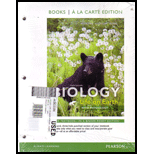
Introduction:
Organic molecules are those molecules which are made up of carbon and hydrogen. Organic molecules consist of a carbon backbone which is bonded to atoms of hydrogen. Carbon is the main constituent of life. The chemical properties of different structures having carbon govern the interactions of cells. Versatile and various carbon atoms which is the key component of organic molecules make life possible. Organic molecules assume complex shape and structure which is important for many biological processes.
Answer to Problem 1FIB
Correct answer:
In organic molecules made of chains of subunits, each subunit is called a (n) monomer, and the chains are called
Explanation of Solution
The long chains of an organic molecule is called polymer. A polymer consists of a repeating unit called monomers. Carbohydrates are made up of carbon, hydrogen and oxygen molecules. Carbohydrates also form polymers having two or more sugar molecules.
Polysaccharides are formed by the long chain of simple monomer units of monosaccharide linked through glycosidic bonds. The examples of some polysaccharides are glycogen, starch, cellulose, and chitin. The long sugar chains can be broken down into simpler units by hydrolysis reactions.
Disaccharide sugar molecules are composed of two monosaccharide units. Example of disaccharide sugars are: maltose, lactose, and sucrose.
Each polymer of an organic molecule is made up of a single repeating unit called monomer. Disaccharide and polysaccharide are the classes of carbohydrates which are made up of two or more monosaccharide. Sucrose and maltose are disaccharide and glycogen and cellulose are polysaccharides.
Want to see more full solutions like this?
Chapter 3 Solutions
Biology
 Human Anatomy & Physiology (11th Edition)BiologyISBN:9780134580999Author:Elaine N. Marieb, Katja N. HoehnPublisher:PEARSON
Human Anatomy & Physiology (11th Edition)BiologyISBN:9780134580999Author:Elaine N. Marieb, Katja N. HoehnPublisher:PEARSON Biology 2eBiologyISBN:9781947172517Author:Matthew Douglas, Jung Choi, Mary Ann ClarkPublisher:OpenStax
Biology 2eBiologyISBN:9781947172517Author:Matthew Douglas, Jung Choi, Mary Ann ClarkPublisher:OpenStax Anatomy & PhysiologyBiologyISBN:9781259398629Author:McKinley, Michael P., O'loughlin, Valerie Dean, Bidle, Theresa StouterPublisher:Mcgraw Hill Education,
Anatomy & PhysiologyBiologyISBN:9781259398629Author:McKinley, Michael P., O'loughlin, Valerie Dean, Bidle, Theresa StouterPublisher:Mcgraw Hill Education, Molecular Biology of the Cell (Sixth Edition)BiologyISBN:9780815344322Author:Bruce Alberts, Alexander D. Johnson, Julian Lewis, David Morgan, Martin Raff, Keith Roberts, Peter WalterPublisher:W. W. Norton & Company
Molecular Biology of the Cell (Sixth Edition)BiologyISBN:9780815344322Author:Bruce Alberts, Alexander D. Johnson, Julian Lewis, David Morgan, Martin Raff, Keith Roberts, Peter WalterPublisher:W. W. Norton & Company Laboratory Manual For Human Anatomy & PhysiologyBiologyISBN:9781260159363Author:Martin, Terry R., Prentice-craver, CynthiaPublisher:McGraw-Hill Publishing Co.
Laboratory Manual For Human Anatomy & PhysiologyBiologyISBN:9781260159363Author:Martin, Terry R., Prentice-craver, CynthiaPublisher:McGraw-Hill Publishing Co. Inquiry Into Life (16th Edition)BiologyISBN:9781260231700Author:Sylvia S. Mader, Michael WindelspechtPublisher:McGraw Hill Education
Inquiry Into Life (16th Edition)BiologyISBN:9781260231700Author:Sylvia S. Mader, Michael WindelspechtPublisher:McGraw Hill Education





